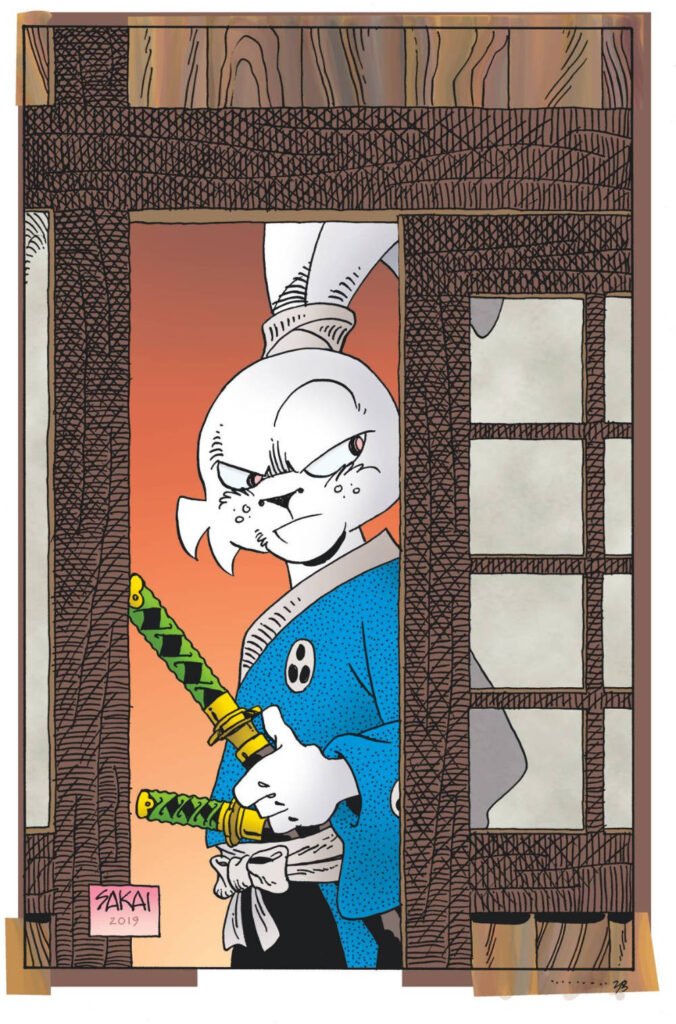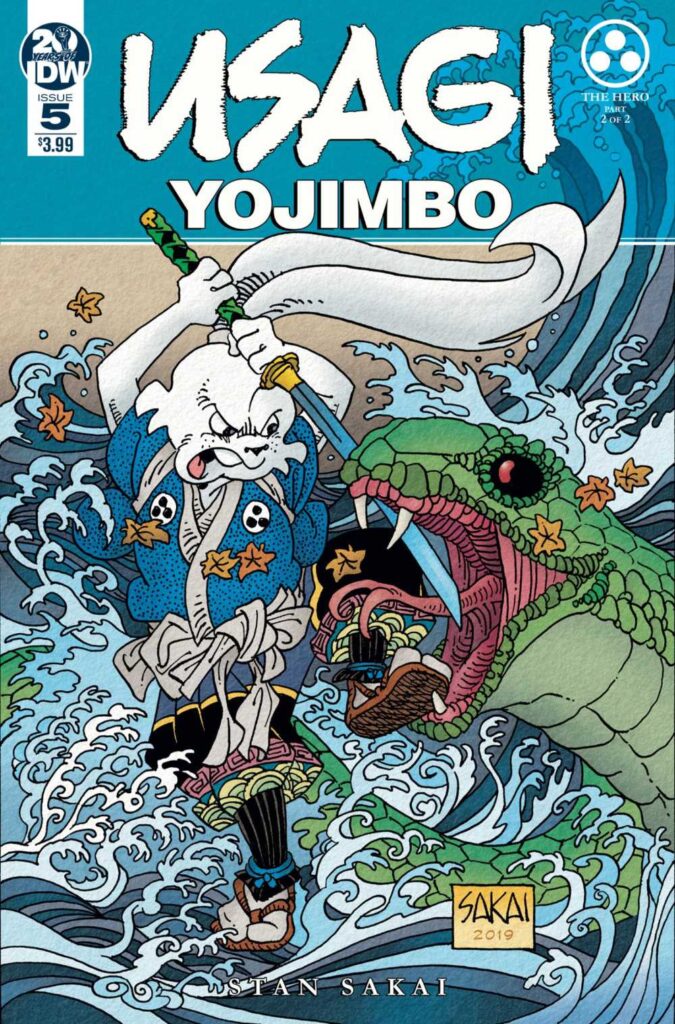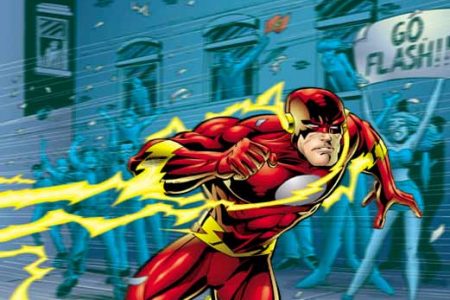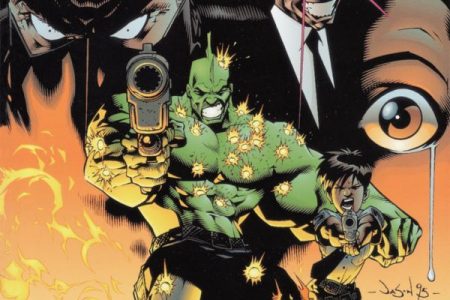As a fan of comic books, I am a fan of comic book art and artists, which is why I do a blog post series about the work of comic book artists I’ve enjoyed. At time of writing, I’ve talked about 18 comic book artists; however, as the pandemic continues and has an impact on the things we do and the way we think, I realised I hadn’t discussed my favourite artists as yet, something I should rectify.
Strangely, the identities of my top five favourite comic book artists were hinted at in a blog post from nearly 15 years ago – I think that must beat Chris Claremont for longest time for seeding an idea and then returning to it … So, onto one of my favourite comic book artists: Stan Sakai.
I should warn you that this post will mostly be about Usagi Yojimbo.

I can’t remember exactly when I first discovered Usagi Yojimbo, but I’m guessing it must have been the early 1990s. I probably heard about the anthropomorphic adventures of a rabbit ronin in Edo-period Japan, saw the trades in a comic book shop and thought (before Tina Fey in 30 Rock), ‘I want to go to there’. And I’ve never looked back.
Stan started out his career doing lettering (notably for Groo the Wanderer, which he continues to this day, and he would eventually be asked by Stan Lee to letter the Spider-Man Sunday newspaper strips when Lee was writing them – he has several Eisner awards for lettering) before writing and illustrating The Adventures of Nilson Groundthumper and Hermy in 1984, before creating Usagi Yojimbo in the pages of Albedo Anthropomorphics; the character would get his own series in 1987 at Fantagraphics. This would last for 38 issues of the regular series, with a few specials, finishing in March 1993.

Due to a friendship with Peter Eastman and Kevin Laird, creators of the Teenage Mutant Ninja Turtles (their books came out at roughly the same time), Stan would bring Usagi Yojimbo to their company, Mirage. This would last 16 issues in full colour (by Tom Luth, who had been doing the covers and still does), starting at the same time the last issue of the Fantagraphics series came out. The connection between Usagi and the Turtles remains strong – they have appeared in each other’s comic books and Usagi has been in the Turtles cartoon on several occasions, and there was a recent one-shot teaming them up written and drawn by Stan.
The longest run of Usagi Yojimbo (more than 170 issues) would be when Stan moved the title to Dark Horse Comics in 1996, reverting to a black-and-white comic book. Originally, I thought this move was part of the Legend imprint at Dark Horse, set up by Frank Miller and John Byrne for creator-owned comic books (other creators would include Mike Mignola, Art Adams, Walter Simonson), but the internet tells me I’m wrong on that. However, this was when I would start buying the individual issues at the comic book shop (as well as continuing to buy the collected editions), an exciting prospect of seeing the stories as they came out. Dark Horse was a good home for Stan because he had complete autonomy – although he had a seasoned editor in Diana Schultz, his work would be published as he had written and drawn it, quite an unusual arrangement. For reasons that I haven’t been able to discern from the internet, Stan has taken the title to IDW Publishing as of 2019, where it is in full colour (by Luth).

Usagi Yojimbo is the story of Miyamoto Usagi (‘Usagi’ is the Japanese word for ‘rabbit’, pronounced ‘oo-sah-ghee’); the basis for the character is the famous swordsman Miyamoto Musashi, who was so good that he would fight duels with a wooden sword. Usagi is a samurai whose master (Lord Mifune – named after Toshiro Mifune, the famous Japanese actor who starred in Yojimbo [‘bodyguard’], the source of the name for the book) is killed at the Battle of Adachigahara Plain (which is where Usagi gained the scar above his left eye). Usagi then becomes a ronin (a masterless samurai), who goes on the warrior’s pilgrimage, occasionally hiring out his services, but mostly travelling through Japan (in the equivalent of the late 16th, early 17th century), meeting some characters regularly but never settling anywhere.
The book is influenced by Japanese chanbara (samurai films) and notable manga such as Lone Wolf and Cub, so there is plenty of sword fighting and adventure. However, it is also entirely its own thing, taking the protagonist into side roads about historical life in Japan at the time, such as kite festivals and the making of tatami mats, as well as including stories of yokai, Japanese monsters and folklore, such as kappa and ghosts. Stan has also indulged his love of science fiction by doing several Space Usagi mini-series, set in the future with a descendant of Usagi, as well as the Senso storyline, set 20 years from Usagi’s current timeline, in which the Martians from War of the Worlds attack Japan.

I absolutely adore Usagi Yojimbo, both the book and the character – he is my favourite comic-book character (we have named one of our cats after him, so I hope the cat doesn’t understand Japanese) and the book is one of my favourites. This is made even more impressive by the fact that it’s been going for more than 35 years, and that it’s a creator-owned black-and-white comic book about a rabbit samurai in a world of other animal creatures (ninjas are bats, his best friend, Gen, is a rhinoceros; there are non-talking animals, such as horses ridden by samurai and nobility, and the tokage – dinosaur-like lizards that roam the countryside).
Stan is responsible for the whole book (apart from the colours by Luth) – he writes, draws and letters every issue of Usagi, in the purest version of a comic book creator producing a story from his brain to the reader’s eyes. His art is deceptively simple, with his pure, clean lines depicting the adventures of animal characters, but it’s incredibly precise and full of detail. His storytelling skills are superlative – the ability to set establishing shots (with all the necessary historical reference needed to recreate feudal Japan), dynamic fight scenes (but with the all-ages touch of no blood and a delightful skull icon floating up to show death), beautiful scenery, intimate moments of drama, the folklore elements, all flowing perfectly from panel to panel and guiding the reader through the comic book page with grace and economy. It’s a delight to read a page, an issue, a collected storyline, not to mention his covers, which I’m mostly posting as examples of Sakai’s art – he has a powerful talent at capturing the perfect moment to represent the story.

Sakai’s art has evolved over the years – Usagi in the early days was more cartoony, not as smooth and refined – as would be expected from a talented artist who has been drawing the same character for decades. But it’s a case of getting better – some artists progress and get a little looser, less detailed, more economic; Sakai has got sharper and more expressive, more precise in his linework. You know you are in the hands of true master of the form (he has won multiple awards, including various Eisner awards, and he was deservingly inducted into the Eisner Hall of Fame this year). Sakai has drawn non-Usagi comic books, notably an adaptation of the 47 Ronin, the famous Japanese story, but he doesn’t need to draw anything else – Usagi Yojimbo is one of the greatest comic book characters and series, and I’m delighted it will get a Netflix animated series in the near future (even if it won’t be adaptations of the original Usagi stories).

It’s difficult to express how much Usagi Yojimbo and the work of Stan Sakai means to me, because it’s been a constant in my life for more than 25 years. I have had a letter printed in the series (issue #73 of the Dark Horse series, the cover of which I’ve included in the collection of images for this reason, despite the fact that I can’t get a high-resolution version), I have watched a theatre adaptation of Usagi Yojimbo, I have an Usagi Yojimbo jigsaw puzzle, I even have an Usagi plushie. The comic books are brilliant, Stan is an underrated master of the form, and more people should be buying the book. Perhaps that will happen when the Netflix series is released, but I’ll be there for the continuing adventures of the rabbit ronin as long as Stan keeps writing and drawing them.




